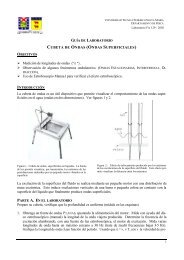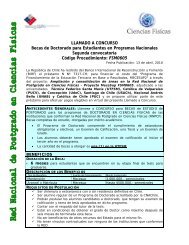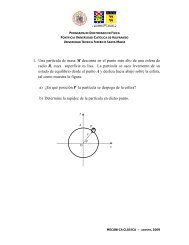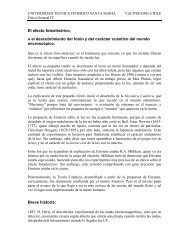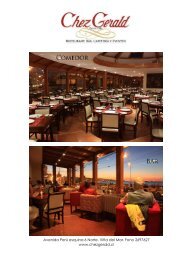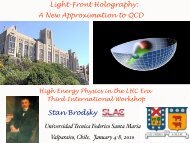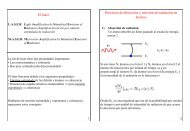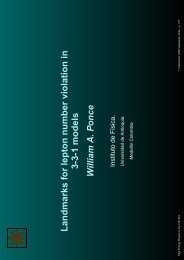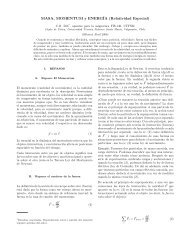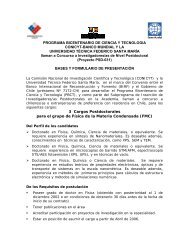Aca - Departamento de Física - Universidad Técnica Federico Santa ...
Aca - Departamento de Física - Universidad Técnica Federico Santa ...
Aca - Departamento de Física - Universidad Técnica Federico Santa ...
You also want an ePaper? Increase the reach of your titles
YUMPU automatically turns print PDFs into web optimized ePapers that Google loves.
V Encuentro Sud Americano <strong>de</strong> Colisiones Inelásticas en la Materia<br />
Fast atom diffraction from metallic surfaces<br />
M.S. Gravielle 1 , G. Bocán 2 , and R. Díez Muiño 3<br />
1 Instituto <strong>de</strong> Astronomía y <strong>Física</strong> <strong>de</strong>l Espacio, CONICET, Bs. As, Argentina, and Depto <strong>de</strong> <strong>Física</strong>,<br />
FCEN, UBA.<br />
2 Centro Atómico Bariloche, CNEA and CONICET, S.C. <strong>de</strong> Bariloche, Río Negro, Argentina.<br />
3 Donostia International Physics Center (DIPC) and C. Fís. Materiales CSIC-UPV/EHU, San Sebastián,<br />
Spain.<br />
E-mail: msilvia@iafe.uba.ar<br />
1. INTRODUCTION<br />
Diffraction from crystal surfaces produced by<br />
grazing scattering of atoms in the keV energy<br />
range is nowadays attracting consi<strong>de</strong>rable attention.<br />
The first experimental evi<strong>de</strong>nces of this<br />
effect were reported for insulator surfaces [1] for<br />
which the presence of a band gap strongly suppresses<br />
inelastic electronic processes, favoring<br />
the conservation of quantum coherence. However,<br />
this diffraction effect has recently been<br />
observed at metallic materials [2,3] as well, although<br />
electron excitations were supposed to<br />
smudge interference signatures for these surfaces.<br />
The aim of this work is to study the<br />
atomic diffraction from metal surfaces by consi<strong>de</strong>ring<br />
keV nitrogen atoms impinging grazingly<br />
on Ag(111) .<br />
2. THEORETICAL MODEL<br />
To <strong>de</strong>scribe the scattering process we employ<br />
a distorted-wave mo<strong>de</strong>l - the surface-eikonal<br />
approximation [4] - that makes use of the eikonal<br />
wave function to represent the elastic collision<br />
with the surface, while the movement of the<br />
fast projectile is <strong>de</strong>scribed classically by consi<strong>de</strong>ring<br />
axially channeled trajectories for different<br />
initial conditions. The surface-eikonal T-matrix<br />
element reads:<br />
r r<br />
(eik)<br />
Tif<br />
= ∫ dRos<br />
aif<br />
( Ros<br />
),<br />
(1)<br />
where R r<br />
<strong>de</strong>termines the initial position of the<br />
os<br />
projectile on the surface plane and<br />
a<br />
if<br />
r<br />
( R<br />
os<br />
r<br />
-3<br />
) = ( 2π)<br />
∫ dt |vz<br />
( RP<br />
) |×<br />
r r r<br />
exp[ -iQ.R -i η(<br />
R )] V<br />
P<br />
P<br />
SP<br />
r<br />
( R<br />
P<br />
)<br />
(2)<br />
is the transition amplitu<strong>de</strong> associated with the<br />
r r<br />
classical path RP<br />
( Ros<br />
, t)<br />
, with Q r the projectile<br />
r<br />
momentum transfer and v z<br />
( RP<br />
) the component<br />
of the projectile velocity perpendicular to the<br />
surface plane. In Eq. (2), η ( R<br />
r P<br />
) is the eikonal-<br />
Maslov phase that takes into account the action<br />
of the projectile-surface potential V ( R<br />
r<br />
SP P)<br />
along<br />
the classical path.<br />
An accurate potential energy surface for the<br />
N/Ag(111) system was <strong>de</strong>rived from <strong>de</strong>nsity<br />
functional theory (DFT) calculations as implemented<br />
in the "Vienna Ab-initio Simulation<br />
Program" (VASP) co<strong>de</strong> [5], combined with an<br />
elaborate interpolation method [6].<br />
3. RESULTS<br />
We apply the theoretical mo<strong>de</strong>l to evaluate<br />
angular projectile distributions for impact along<br />
different low-in<strong>de</strong>x crystallographic directions.<br />
The influence of the inci<strong>de</strong>nce energy and the<br />
symmetry of the consi<strong>de</strong>red channel are both<br />
analyzed.<br />
32 Valparaíso, Chile



